Soft Hands when Riding Start with Your Wrist (and thumb): Improve Feel and Rein Control
- pegasusphysiotherapy
- Jul 19
- 6 min read
Updated: Oct 1
Thumb Position in Horse Riding: Not Quite a 5000-Word Essay, But Close Enough
Someone recently commented on a social media post that I “overcomplicate riding,” joking that the next thing I’d do was a 5,000-word essay on thumb position.
Well… not 5,000 words. Just a blog post 😊
But let’s talk about why wrist and thumb position matter in horse riding. We always hear advice like “have soft hands,” “keep a steady contact,” or “feel the horse’s mouth,” but rarely does anyone explain what your hands, wrists, and fingers actually need to do to make that happen.
Why Wrist Position Matters in Horse Riding- and how that leads to soft hands when riding
When we talk about wrist alignment, we’re not aiming for textbook anatomical neutral (0° extension). In riding, you’re holding the reins with bent fingers- which means what we actually want is a functional neutral wrist position.
In sports biomechanics, functional neutral is where your wrist is slightly extended- typically 15–30° (dependent on individual anatomy/conformation) and allows your fingers to work independently while keeping the forearm relaxed.
🔍 According to O’Driscoll et al. (1992), grip strength and control peaked when the wrist was in 35° of extension and slight ulnar deviation, not flat. That’s where the body works best- and that includes when you’re riding a horse.
📚 Other research has confirmed that slight wrist extension reduces fatigue and improves finger coordination, especially in tasks requiring subtle hand control. So if you're aiming to improve your rein contact or develop a lighter feel with your hands, this is a crucial foundation.

Thumb and Finger Position for Riders
When your wrist is correctly aligned, the thumb rests on top of the rein- not clamping it, just gently stabilising it. Your third and fourth fingers (ring and little finger) should control the reins with subtle movements, not the whole arm or wrist.
But problems start when your wrist isn’t in the right place which changes where the thumb goes (thumb follows wrists normally than the other way around):
Pronation (thumbs face each other): elbows stick out, and you lose finger isolation. (The opposite way - supintaion- can happen but is rare as much harder to do)
Ulnar deviation (thumbs point downward- so you can't see the end of the thumb): wrist drops down, tension builds- can cause ulna (little finger sided) wrist pain or thumb tendon issues like De Quervain’s. Can happen when hands are held too high.
Radial deviation (thumbs too high): wrist locks, reducing feel and responsiveness.
Extension (knuckles face outwards) and often what people call a 'broken' wrist, and often happens when hands are too close together- if they didn't extend the wrists then reins would be pressing into side of horses neck
Flexion (knuckles facing inwards) - just holding this position at rest causes tension in forearm- never mind when holding reins.
Left- hands too high and wrists in ulna deviation.
Right- hands too low and wrists in pronation.
These positions interfere with the subtle, independent finger movement that defines good rein contact. So yes thumb position matters because by looking at what that is doing means you can start to see what your wrist is doing.
What Does “Feel” Really Mean in Horse Riding?
Let’s bust the myth- “feel” isn’t just something that you necessarily get by doing more.
Feel comes from being able to use your fingers in small, controlled movements - holding the rein like you’re holding a baby bird (you’ve heard that one, right?). Soft enough not to crush it, firm enough not to drop it. Trouble is, a lot of riders would be choking their bird.
Feel means being able to apply or release pressure in tiny increments, and maintain it without locking up your wrist, shoulder, or forearm. And the feel comes from the 4th finger mainly.

I recently saw a brilliant video where a rider held a sponge in their palm, without touching the thumb or index finger. Just squeezing the sponge gently with the ring and little fingers created the contact and feel they were looking for. It perfectly showed how feel comes from functional finger control, not gripping with your whole hand.
This is the foundation of developing soft hands in riding- and it all starts with wrist and thumb alignment.
Exercises to Improve Rein Contact and Hand Position
🟢 The Paper Test Off-horse, hold a flat piece of paper (make sure horizontal) between your thumb and index finger. Don’t squash it- but don’t drop it either. That’s the kind of light thumb pressure we want on the rein. If someone pulls it away you are able to press down to stop it being pulled away without needing constant tension.
🟢 4th Finger Rein Control- Hold the reins with just your ring fingers (off the horse) and see how small movements adjust the rein without needing your whole hand or arm. Can you isolate just that finger?
🟢 Point Your 4th Finger at the Bit On-horse, this cue helps align your hand height with the horse’s frame. It maintains consistent rein angle and contact while allowing the wrist to stay in functional neutral. And helps create the triangle from elbow to wrist to bit from horses neck.
Rider Posture Affects Hand and Wrist Position
But your wrist can’t function well if the rest of your body is out of alignment. Rounded shoulders, stiff elbows, or an anterior pelvic tilt can all throw your wrist and thumb position off.
That’s why I always address full-body rider biomechanics in my sessions- not just the hands. The wrist is just the last link in the chain. But it can sometimes be as simple as correcting the rein hold and wrist position to help and it's a great place to start.
I encourage riders to work on finger dexterity as well as wrist strengthening in my sessions and as part of the video subscription to help with their riding.
If the aim becomes hands together then elbows become too narrow and wrists turn out, often one shoulder lifts/drops to compensate (left) whereas when elbows relaxed by side and wrists in neutral then a clear line from elbow to bit (right). On the left there is a line from thumb to bit but, more on the right hand, you can see there isn't a line from elbow to rein without a kink in it.
SymmFit: Helping You See and Feel It
I’m really excited to be launching a new product as part of the SymmFit range for riders- a tool to help you improve hand awareness, rein feel, and wrist alignment. The Insight Gloves are now available to buy online to help you see exactly what you are doing with your wrists and hands!
Just like our SymmFit training tops and jodhpurs help you identify imbalances in the saddle, this will help you become aware of what your hands and fingers are doing, and how to improve it through feedback and feel- not being held or bracing into a position.
Final Thoughts
Soft hands when riding aren’t about letting the reins go slack or being floppy- they’re about connection, consistency, and clear communication. And all of that starts with the wrist, thumb, and fingers working together, in the right position, with the right muscles.
If you’re aiming to develop truly soft hands when riding, it starts with understanding wrist alignment and functional control
So no- it’s not a 5000-word essay. But it is a deep dive into why hand and wrist alignment matters more than most riders realise. And this is just about the thumb/wrist position at rest never mind how that then affects the ability of the arm to follow the horses head movement or help/hinder on a circle with inside/outside rein contact!
.png)





















Comments